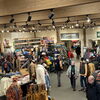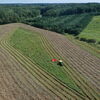Easy redemption | With proprietary software and a streamlined process, Scarborough-based CLYNK rethinks how consumers return bottles and cans
At least that was the rationale behind Scarborough-based company CLYNK, which developed a way to bring consumers and their nickels back together without sticky residue or stale-beer smells. The CLYNK model is based on a complex software program and network that counts and crushes cans and bottles, separates them by distributor, records data, and deposits money into the appropriate customer account at breakneck speed.
"I was trying to figure out a way to bring some technology to a wholly inefficient process," says Frank Whittier, CLYNK's co-founder and senior vice president of marketing and business development. "The process was fairly archaic and inefficient ˆ totally manual ˆ and there was not a lot of document and record keeping. It was pretty unsophisticated."
Whittier's hope is that CLYNK will change the way consumers redeem bottles and cans. And, along the way, he aims to replace the redemption centers that grace many grocery store entrances in Maine and other states.
To that end, CLYNK in 2005 struck a deal with Scarborough-based Hannaford Supermarkets to overhaul the redemption centers in 11 of the company's grocery stores in Maine. In stores from York to Brunswick, the process of returning bottles and cans is reduced to handing a bag of returnables over to a CLYNK worker, who scans the bag's barcode. The redemption money is then deposited into the customer's account.
Whittier calls it a win-win situation. "Hannaford got the bottle-crushing process out of the front of their grocery store," he says. Meanwhile, distributors get accurate data about their products, and customers get what they want ˆ their refund with minimal effort on their part. No fuss, no muss, no sticky liquids.
This year, CLYNK plans to roll out its service to two or three new Hannaford stores per month, bringing its total number of locations to 27 by the end of the year.
So far, the reaction has been overwhelmingly positive: Whittier says CLYNK is so popular in Scarborough, where the company's count-and-crush technology was originally introduced, that 95% of the town's households have signed up for the service.
The biggest hurdle CLYNK has cleared is convincing customers to get on board with the card-based system, created when the company secured its contract with Hannaford. First up was an amendment to the Maine Bottle Bill, passed in 1978, which stipulated that the refund had to be given to customers immediately upon the return of their bottles and cans. Now CLYNK has up to 48 hours to transfer the refund into the customer's account.
Ultimately, CLYNK hopes to scale its patented technology to other, non-bottle-bill states, which Whittier says will be a challenge because the United States does not have a strong history of recycling and with the advent of bottled water, landfills are more cluttered than ever before.
"As a country we're barely recycling the beverage containers we use," he says. "It's below 20%. How can we take what we've learned in Maine [and] model it to a non-bottle-bill environment?"
Counting and crushing
Whittier discovered the technology on which CLYNK is based in a garage in Biddeford Pool in 2004 while working for his company, Evergreen Environmental, which picked up and returned bottles to distributors. He says he came across Count & Crush Systems Inc. and knew he had the means to make the technology a reality. Whittier bought out the patent holders for an undisclosed amount and proceeded to tweak the software over the next two years.
The evolution of CLYNK is the result of countless hours logged by a small army of engineers, software programmers and Web designers. The company has received financial backing and management expertise from a managing partner, CHK Capital Partners LLC, a South Portland investment firm led by Peter Cianchette, Clayton Kyle and Bill Hunscher, who Whittier lists as a co-founder of CLYNK. According to CHK, the firm has been "actively involved in CLYNK since its inception."
After hundreds of thousands of dollars in investments and the successful development of a prototype, CLYNK needed a partner to introduce its service to consumers. By late 2005, CLYNK secured an exclusive deal with Hannaford and was in the process of developing the "Drop & Go" card-based system that works similar to an online bank. (Hannaford did not respond to repeated requests to comment on this story.) Customers sign up, purchase CLYNK's signature bags for 20 cents apiece (the first two are free), fill them with bottles and cans and drop them off at any CLYNK location. The bags are picked up and trucked to CLYNK's headquarters, and scanned and sorted by the CLYNK machines. The barcode on the side of the bag automatically loads the value into the customer's online account, usually within less than 48 hours. The account can be redeemed for cash or store credit.
The results are fast and efficient.
"[It crushes] 100 units per minute," says Stan Brooks, project engineer at Knowlton Machine Engineering, the Gorham-based company that engineers and builds CLYNK's count-and-crush machines.
Inside the CLYNK warehouse, Whittier gestures to the intricate line of four bottle-processing machines and says two years ago CLYNK was processing 4,000 cans a day. "I thought that was big," he says, adding CLYNK now processes in excess of 100,000 bottles and cans per day. "A handfed reverse-vending machine can crush maybe 20 per minute, but they don't do a complete sort."
The company is scheduled to move its processing business to a new 20,000-square-foot facility in South Portland this month. Its administrative offices will remain in Scarborough, but the move to South Portland will double its current processing space, and Whittier says CLYNK will add four more processing machines by the middle of the year.
In the processing facility, CLYNK sorts up to 250 different kinds of bottles and cans. The database communicates with the machine, which separates the bottles by glass, plastic and color. The recyclables are then baled and stacked, ready to be picked up by distributors, which are required under Maine's bottle laws to retrieve the containers they distribute.
CLYNK CEO Tracy Hawkins says what's unique about CLYNK is the data collected during the count-and-crush process. It's data the CLYNK team says has never been captured before.
Hawkins uses the example of a bottle of beer. If a customer were to buy a six-pack of beer in Cumberland County, but return the bottles in York County at a traditional redemption center, it's unlikely the bottles would get returned to the correct distributor because the typical redemption system doesn't always count UPC codes. "The geography can be by the county, by the store ˆ that's what the challenge is," Hawkins says. "It's complex."
Distributors benefit because each bottle is weighed and verified to ensure it's returned to the correct distributor. In turn, the distributor benefits by knowing where the products are being sold and returned.
The CLYNK software also can keep track of the types of beverages consumed by particular households, providing untapped market research that Hawkins says could be very valuable to distributors. (Hawkins, however, stresses that CLYNK has a firm policy to protect such data, and that the company has no plans to sell that information to outside sources.)
Consumer confidence
Hawkins says CLYNK has debuted at the right time, when people are more environmentally conscious than ever before and eager to reduce their carbon footprint.
"It makes it easy for people to do the right thing," she says. "No other model has been designed with the consumer in mind."
Consumers are showing their approval by signing up for the technology in record numbers, and CLYNK now counts among its members 28,000 households in Maine. The company began in 2005 with just five employees. That number grew to 90 at the end of 2007, and is expected to more than double by the end of 2008.
Colin McGuire, senior consultant for Portland-based Fortress Network Solutions Inc., designed and built the CLYNK network. He says though the network is basically straight forward, the challenge is dealing with Maine's multiple telecommunication carriers and creating a network that's compatible. "The network design wasn't anything revolutionary," he says. "It's a centralized data model communicating back into the system in real time."
He speculates the technology is so popular because CLYNK understands people have better things to do than wait in line with a bag of returnables. "There's better use of most folks' time," says McGuire.
For the more traditional consumer, CLYNK will still hand-count up to 50 bottles and cans, but for on-the-go customers, it also offers a night drop box, which usually nets about 20 bags each evening.
For Whittier, the hard work and sleepless nights are paying off. Though he declines to discuss specifics, Whittier says CLYNK's financials are "on plan."
For CLYNK, the future is about innovation. At its core is a slick and easy-to-navigate website, which is expected to soon offer consumers online access to their accounts, allowing them to check balances and apply their account balance toward special offers from "green" partners that peddle environmentally friendly products.
"Going forward, we see a lot of opportunity for community building," says Bryan Hynes, a New York-based principal of Hynesight Brochu, which developed the CLYNK website.
He describes a future where consumers will be able to support community programs or organizations via their My Space or Facebook pages with their CLYNK account. This, Hynes says, makes the typical bottle drive almost obsolete. Instead of hauling truck loads of cans and bottle to the redemption center, a charity can obtain a barcode and make it available to anyone that wants to donate their bottles and cans to the organization.
"A lot of what's going to happen will be based on the feedback we get from customers," he says. "The sky's the limit."










Comments